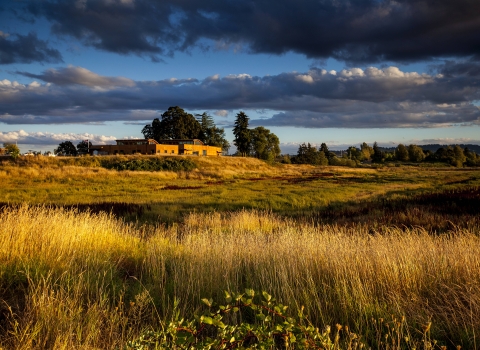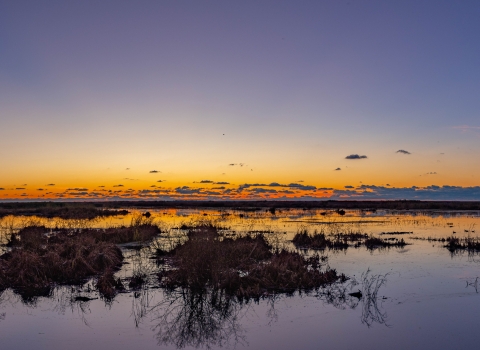At a time when news about bats is generally bad, the lesser long-nosed bat is bucking the trend. The story of how this southwestern pollinator recovered from historic lows to the point where it could today be proposed for removal from the federal list of endangered and threatened wildlife exemplifies the power of the Endangered Species Act (ESA) in driving collaborative conservation. And it shows just how well the ESA works when given the time and resources to do so.
When initially protected under the ESA in 1988, the nectar-feeding lesser long-nosed bat was struggling for survival. Today, vastly improved numbers of bats and roosts in the U.S. Southwest and Mexico have conservation partners anticipating that their 30-year recovery efforts have paid off. In 1988, there were thought to be fewer than 1000 bats at the 14 known roosts range wide. There are now an estimated 200,000 bats at 75 roosts. Consequently, the U.S. Fish and Wildlife Service is proposing to remove the bat from the ESA’s protections.
“This has been an international team effort involving citizen scientists in Pima County, tequila producers in Mexico, biologists in both the U.S. and Mexico, non-governmental organizations and federal and state agencies, all pulling together under the organizing banner of the Endangered Species Act,” said the Service’s Arizona Field Supervisor, Steve Spangle. “These collaborative efforts have succeeded in recovering this important pollinator and seed disperser, contributing to healthy soils and habitats, and providing sustainable economic benefits for communities.”
For a decade, southern Arizona residents have monitored night-time bat use of hummingbird feeders. These data have provided biologists with a clearer understanding of lesser long-nosed bat migration timing. They have also provided biologists with the opportunity to capture bats and affix radio transmitters that aided in finding roost sites.
In the United States, most lesser long-nosed bat roosts and forage areas are managed by federal agencies (U.S. Forest Service, Bureau of Land Management, National Park Service and the Army’s Fort Huachuca), which have integrated the management of lesser long-nosed bat forage plants – agaves, and saguaro and organ pipe cacti – into their land use and resource management plans. Additionally, agencies are aiding in deterring human disturbance of roost site caves and abandoned mines through site closures, law enforcement, and together with state agencies and Bat Conservation International, the design, research and installation of bat gates that allow bat access to roost sites and eliminate human access.
In Mexico, tequila producers, who rely on and cultivate agaves, are increasingly integrating harvest and cultivation practices in recognition that agaves rely on bats for pollination and are even marketing “bat friendly tequila.” Historically, the control of vampire bats for rabies vector control and to reduce impacts to the livestock industry, destroyed roost sites of non-target bats like the lesser long-nosed bat. An active education campaign to change attitudes regarding the conservation of bats and improved bat identification is showing success in long-nosed bat conservation. As a result of reduced threats and the positive lesser long-nosed bat population response, the bat was removed Mexico’s endangered species list in 2015.
The Service, relying on input from lesser long-nosed bat and climate change climate change
Climate change includes both global warming driven by human-induced emissions of greenhouse gases and the resulting large-scale shifts in weather patterns. Though there have been previous periods of climatic change, since the mid-20th century humans have had an unprecedented impact on Earth's climate system and caused change on a global scale.
Learn more about climate change specialists, completed a substantial, peer-reviewed species status assessment of the bat. The delisting proposal draws upon this scientific evaluation of threats and an assessment of the bat’s long-term viability. The science clearly shows that the threats to bat have been eliminated or reduced to the point that the bat has recovered and no longer meets the definition of endangered or threatened under the ESA.
Lesser long-nosed bats range from southern Mexico to southern Arizona and New Mexico. Some Mexican populations are year-round residents, but others are migratory – leaving southern Mexico to find maternity roosts in northern Mexico and the U.S. Southwest where arriving pregnant females have access to forage for birthing and nursing their pups. The bats’ migrations and maternity roosting are reliant on timing and location of the “nectar trail” – the blooming and fruiting season of agaves, saguaro and organ pipe cacti, and other flowering plants that provide their nutrient-rich nectar diet. Bat colonies seek out roost sites in caves, abandoned mines and large crevices, and will travel up to 40 miles each night to reach their nocturnal foraging areas.
The species status assessment also considered the potential effects that climate change may have on the “nectar trail” and the bat’s foraging, migration and roosting. The lesser long-nosed bat has shown the ability to adapt to adverse forage conditions, and biologists found that its flexible and adaptive behaviors will allow it to remain viable under changing climatic conditions.
If the lesser long-nosed is delisted, the Service would continue to work with partners to monitor its status for a minimum of five years after delisting. A post-delisting monitoring plan will describe monitoring methods, reporting procedures and agency responsibilities, and be published in draft form for public comment prior to the final delisting rule.
The Service is requesting comments or information on the delisting proposal. Comments must be received on or before March 7, 2017 and can be submitted by one of the following methods:
(1) Electronically: Go to the Federal eRulemaking Portal: http://www.regulations.gov. In the Search box, enter FWS–R2–ES–2016–0138 which is the docket number for this rulemaking. Then, in the Search panel on the left side of the screen, under the Document Type heading, click on the Proposed Rules link to locate this document. You may submit a comment by clicking on “Comment Now!”
(2) By hard copy: Submit by U.S. mail or hand-delivery to: Public Comments Processing, Attn: FWS–R2–ES–2016–0138; U.S. Fish & Wildlife Headquarters, MS: BPHC, 5275 Leesburg Pike, Falls Church, VA 22041-3803.



